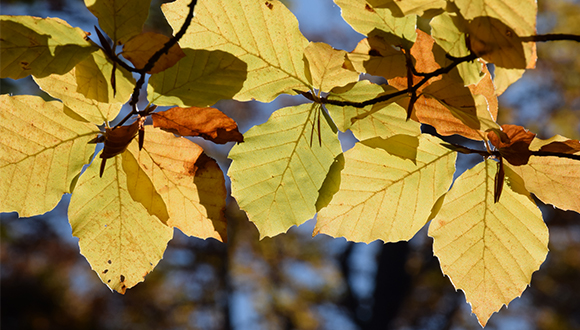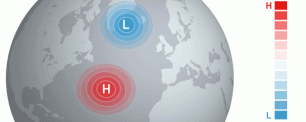When the spring is warm and dry, seed production is increased in forests across Western Europe
Large continental-scale atmospheric phenomena such as the North Atlantic Oscillation (NAO) can be a much better predictor of the quantity of seeds produced by a large portion of Europe's forests, as well as the synchronicity of their production
It is well known that local meteorological conditions are a part of predicting plants' ability to produce seeds; it is also known that the quantity of seeds and timing of their production changes from year to year. However, large continental-scale atmospheric phenomena such as the North Atlantic Oscillation (NAO) can be a much better predictor of the quantity of seeds produced by a large portion of Europe's forests, as well as the synchronicity of their production - in other words, to what degree this is done in a simultaneous manner. This is the main conclusion of a study published in the journal Ecography which had the participation of researchers from CREAF, CSIC, and the University of Antwerp.
The research, carried out in 76 monospecific forests (composed of a single species) in France, Germany and Luxemburg, focused on six types of trees: fir (Abies alba), spruce (Picea abies), Douglas fir (Pseudotsuga menziesii), beech (Fagus sylvatica), sessile oak (Quercus petraea), and pedunculate oak (Quercus robur).

The NAO can explain why the quantity of seeds produced changes from year to year
The NAO is an atmospheric phenomenon ―similar to El Niño in the Pacific― that is generated over the Northern Atlantic and determines the climate of the whole of Europe. It is caused by fluctuations in the difference of atmospheric pressure between the Azores High and the Icelandic Low. The NAO has two phases. In the first, the difference in pressure between the High and the Low is large (when both are very powerful) and the Azores High is moved westward. The second phase occurs when the difference in pressure between the High and Low is small (when both are weak) and the Azores High is displaced eastward.

"It would be excessive to say that annual fruit production is totally dependent on the NAO, but we do see that its condition in each season of the year is the best predictor of the quantity and synchronicity of seed production"
MARCOS FERNÁNDEZ-MARTÍNEZ, autor principal de l’estudi i investigador del CREAF.
The meteorological conditions of Europe change depending on the state of the NAO. For example, when the High and Low are both very powerful, winters are mild and wet over most of Europe because humid air masses are moved over the continent from the Atlantic. On the other hand, when both the Iceland Low and Azores High are weak, winters are typically dry and cold over most of the continent due to the arrival of dry air currents. Thanks to this study, it has now been seen that the status of the NAO in each season ―not just during the winter, the period for which the phenomenon has traditionally been studied― greatly influences the quantity of seeds produced by forests. Thus, it seems to be the case that atmospheric phenomena such as the NAO, shaping a large number of meteorological variables at the continental scale ―including temperature, precipitation, humidity, wind, radiation, atmospheric pressure― are often "better predictors of certain ecological processes than any of these variables when considered individually or in combination," says the CREAF researcher.

For trees such as the pedunculate oak, beech, and firs - species that distribute pollen using the wind - dry and warm springs are particularly important for the production of a large number of seeds.
For trees such as the pedunculate oak, beech, and firs - species that distribute pollen using the wind - dry and warm springs are particularly important for the production of a large number of seeds. In this way, the optimum conditions are created for the pollination of these species, which disperse the pollen through the wind, which will lead to a large production of fruits. However, the other seasons must also be considered since autumn is crucial for building reserves for leaf and flower production the following spring, especially for deciduous species.
Marcos explains that, for example, "oaks and firs both prefer warm and humid autumns for the production of a large amount of seeds in spring because this way leaf fall and dormancy is delayed and they are able to build up more reserves over a longer period." On the other hand, for the evergreen firs, winters with mild temperatures and abundant precipitation are necessary for high seed production.
Greater similarity in environmental conditions promotes forest synchronicity
The study has also demonstrated that synchronicity in seed production is also closely associated with the NAO.
The study has also demonstrated that synchronicity in seed production - understood as the timing of seed production unfolding between any given two forests - is also closely associated with the NAO. The atmospheric phenomenon influences atmospheric conditions over the whole of Europe, so the signals received by trees are bound to be similar across the continent. Such homogeneity of perceived stimuli makes it so that, if the conditions are right, trees of the same species across Europe or even forests of different species will have increased synchronicity of fruit production. In a nutshell, greater similarity in environmental conditions and signals between any given two places will lead to higher synchronicity of fruit production.

Dry and warm springs favor synchronicity between forests of the same species at the continental level due to positive effects of pollination, this being particularly the case for beech forests. The study also shows how, on a smaller scale, local meteorological conditions and geographic distance between forests play a key role in synchronicity. "The smaller the distance between two places, the more similar their environmental conditions are going to be, and as a result, when considering two forests with the same dominant species, their synchronicity at the time of seed production is probably going to be higher," says Marcos Fernández-Martínez.
REFERENCE ARTICLE
Fernández-Martínez, M., Vicca, S., Janssens, I.A., Espelta, J.M., Peñuelas, J. The North Atlantic Oscillation synchronises fruit production in western European forests. (2016) Ecography. DOI: 10.1111/ecog.02296






